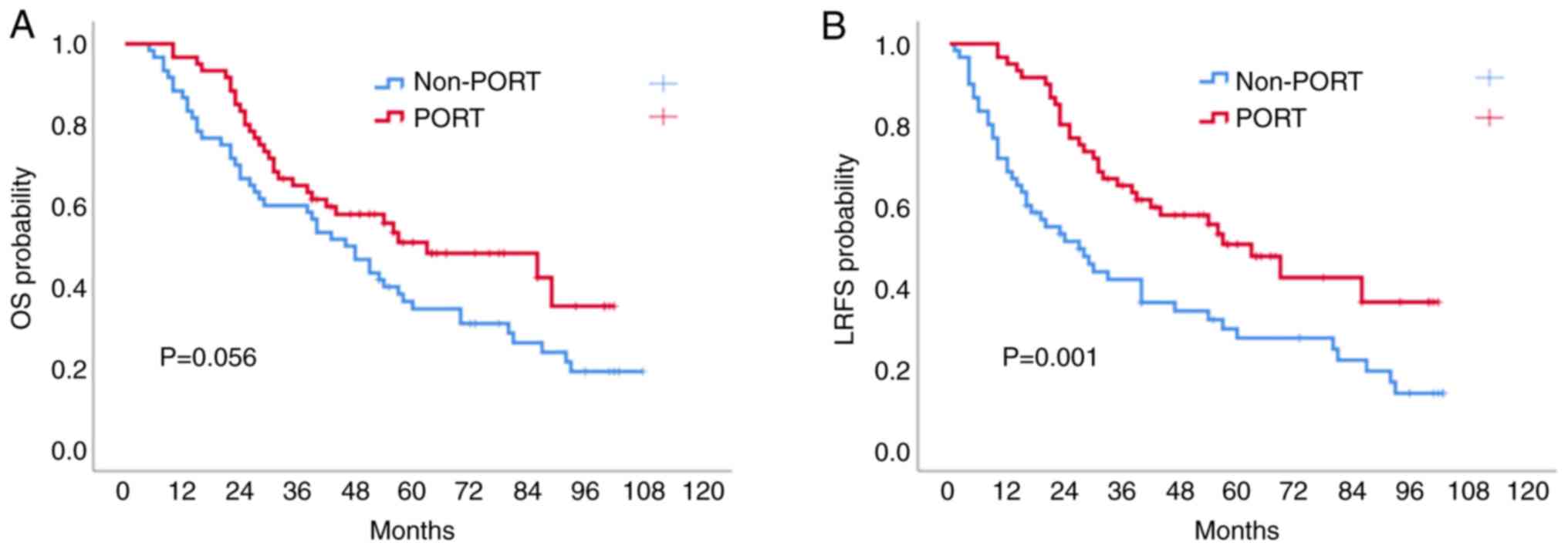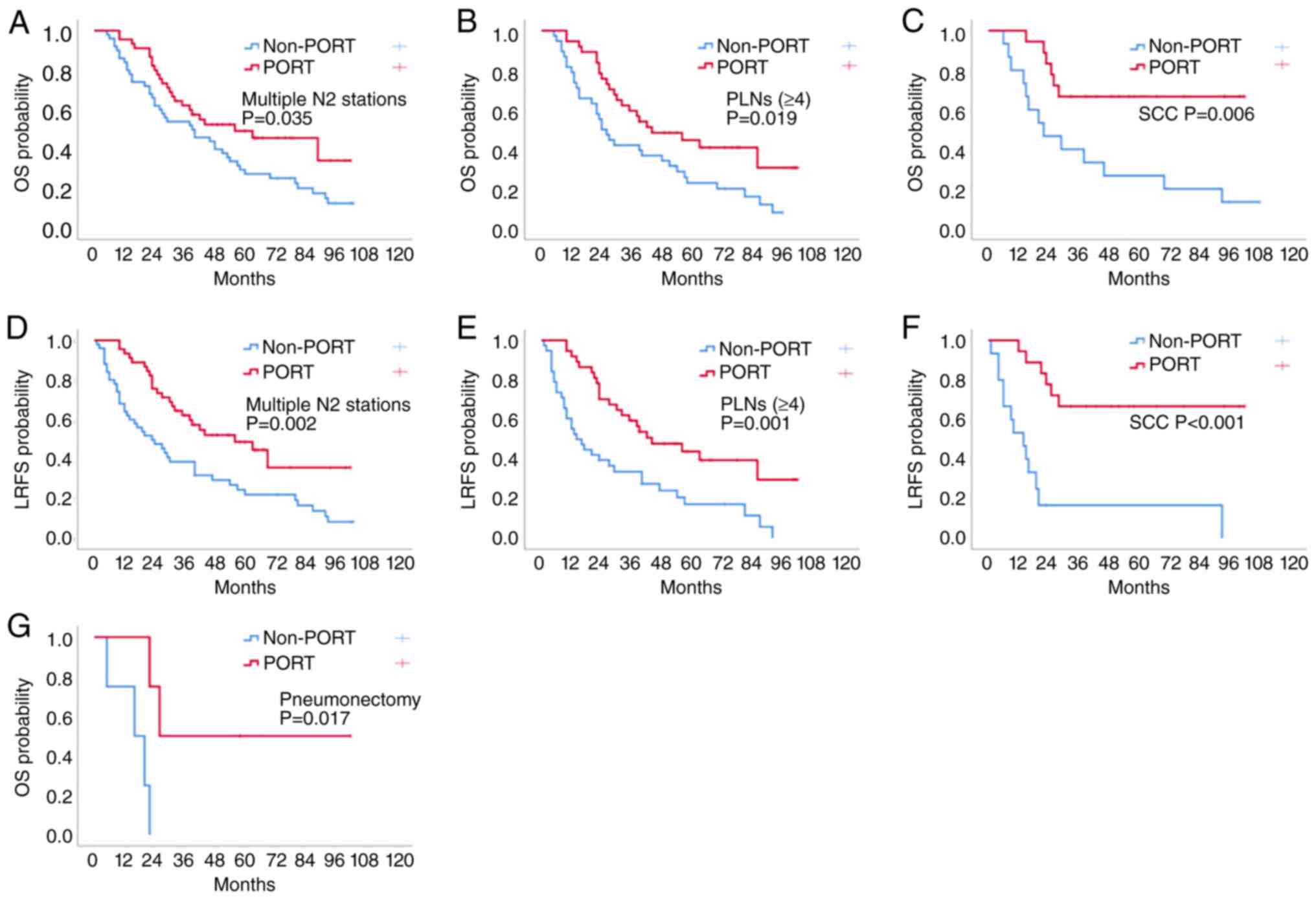|
1
|
Goldstraw P, Chansky K, Crowley J,
Rami-Porta R, Asamura H, Eberhardt WE, Nicholson AG, Groome P,
Mitchell A, Bolejack V, et al: The IASLC lung cancer staging
project: Proposals for revision of the TNM stage groupings in the
forthcoming (Eighth) Edition of the TNM Classification for Lung
Cancer. J Thorac Oncol. 11:39–51. 2016. View Article : Google Scholar : PubMed/NCBI
|
|
2
|
Groome PA, Bolejack V, Crowley JJ, Kennedy
C, Krasnik M, Sobin LH and Goldstraw P; IASLC International Staging
Committee; Cancer Research and Biostatistics; Observers to the
Committee; Participating Institutions, : The IASLC lung cancer
staging project: Validation of the proposals for revision of the T,
N, and M descriptors and consequent stage groupings in the
forthcoming (seventh) edition of the TNM classification of
malignant tumours. J Thorac Oncol. 2:694–705. 2007. View Article : Google Scholar : PubMed/NCBI
|
|
3
|
Vinod SK and Hau E: Radiotherapy treatment
for lung cancer: Current status and future directions. Respirology.
25 (Suppl 2):S61–S71. 2020. View Article : Google Scholar
|
|
4
|
Spigel DR, Faivre-Finn C, Gray JE, Vicente
D, Planchard D, Paz-Ares L, Vansteenkiste JF, Garassino MC, Hui R,
Quantin X, et al: Five-Year survival outcomes from the PACIFIC
Trial: Durvalumab after chemoradiotherapy in stage III
Non-Small-Cell lung cancer. J Clin Oncol. 40:1301–1311. 2022.
View Article : Google Scholar : PubMed/NCBI
|
|
5
|
Postoperative radiotherapy in
non-small-cell lung cancer, . Systematic review and meta-analysis
of individual patient data from nine randomised controlled trials.
PORT Meta-analysis Trialists Group. Lancet. 352:257–263. 1998.
View Article : Google Scholar : PubMed/NCBI
|
|
6
|
Le Pechoux C, Pourel N, Barlesi F, Lerouge
D, Antoni D, Lamezec B, Nestle U, Boisselier P, Dansin E, Paumier
A, et al: Postoperative radiotherapy versus no postoperative
radiotherapy in patients with completely resected non-small-cell
lung cancer and proven mediastinal N2 involvement (Lung ART): An
open-label, randomised, phase 3 trial. Lancet Oncol. 23:104–114.
2022. View Article : Google Scholar : PubMed/NCBI
|
|
7
|
Hui Z, Men Y, Hu C, Kang J, Sun X, Bi N,
Zhou Z, Liang J, Lv J, Feng Q, et al: Effect of postoperative
radiotherapy for patients with pIIIA-N2 Non-Small cell lung cancer
after complete resection and adjuvant chemotherapy: The phase 3
PORT-C randomized clinical trial. JAMA Oncol. 7:1178–1185. 2021.
View Article : Google Scholar : PubMed/NCBI
|
|
8
|
Matsuguma H, Nakahara R, Ishikawa Y,
Suzuki H, Inoue K, Katano S and Yokoi K: Postoperative radiotherapy
for patients with completely resected pathological stage IIIA-N2
non-small cell lung cancer: Focusing on an effect of the number of
mediastinal lymph node stations involved. Interact Cardiovasc
Thorac Surg. 7:573–577. 2008. View Article : Google Scholar : PubMed/NCBI
|
|
9
|
Kim BH, Kim HJ, Wu HG, Kang CH, Kim YT,
Lee SH and Kim DW: Role of postoperative radiotherapy after
curative resection and adjuvant chemotherapy for patients with
pathological stage N2 non-small-cell lung cancer: A propensity
score matching analysis. Clin Lung Cancer. 15:356–364. 2014.
View Article : Google Scholar : PubMed/NCBI
|
|
10
|
Wang S, Ma Z, Yang X, Wang Y, Xu Y, Xia W,
Chen R, Qiu M, Jiang F, Yin R, et al: Choice of postoperative
radiation for stage IIIA pathologic N2 non-small cell lung cancer:
Impact of metastatic lymph node number. Radiat Oncol. 12:2072017.
View Article : Google Scholar : PubMed/NCBI
|
|
11
|
Hui Z, Dai H, Liang J, Lv J, Zhou Z, Feng
Q, Xiao Z, Chen D, Zhang H, Yin W and Wang L: Selection of proper
candidates with resected pathological stage IIIA-N2 non-small cell
lung cancer for postoperative radiotherapy. Thorac Cancer.
6:346–353. 2015. View Article : Google Scholar : PubMed/NCBI
|
|
12
|
Yuan C, Tao X, Zheng D, Pan Y, Ye T, Hu H,
Xiang J, Zhang Y, Chen H and Sun Y: The lymph node status and
histologic subtypes influenced the effect of postoperative
radiotherapy on patients with N2 positive IIIA non-small cell lung
cancer. J Surg Oncol. 119:379–387. 2019.PubMed/NCBI
|
|
13
|
Nguyen SK, Masson-Cote L, Fortin A and
Dagnault A: Influence of smoking status on treatment outcomes after
post-operative radiation therapy for non-small-cell lung cancer.
Radiother Oncol. 96:89–93. 2010. View Article : Google Scholar : PubMed/NCBI
|
|
14
|
Billiet C, Decaluwe H, Peeters S,
Vansteenkiste J, Dooms C, Haustermans K, De Leyn P and De Ruysscher
D: Modern post-operative radiotherapy for stage III non-small cell
lung cancer may improve local control and survival: A
meta-analysis. Radiother Oncol. 110:3–8. 2014. View Article : Google Scholar : PubMed/NCBI
|
|
15
|
Kou P, Wang H, Lin J, Zhang Y and Yu J:
Male patients with resected IIIA-N2 non-small-cell lung cancer may
benefit from postoperative radiotherapy: A population-based
survival analysis. Future Oncol. 14:2371–2381. 2018. View Article : Google Scholar : PubMed/NCBI
|
|
16
|
Betticher DC, Hsu Schmitz SF, Totsch M,
Hansen E, Joss C, von Briel C, Schmid RA, Pless M, Habicht J, Roth
AD, et al: Prognostic factors affecting long-term outcomes in
patients with resected stage IIIA pN2 non-small-cell lung cancer:
5-year follow-up of a phase II study. Br J Cancer. 94:1099–1106.
2006. View Article : Google Scholar : PubMed/NCBI
|
|
17
|
Douillard JY, Rosell R, De Lena M, Riggi
M, Hurteloup P and Mahe MA; Adjuvant Navelbine International
Trialist Association, : Impact of postoperative radiation therapy
on survival in patients with complete resection and stage I, II, or
IIIA non-small-cell lung cancer treated with adjuvant chemotherapy:
The adjuvant Navelbine International Trialist Association (ANITA)
Randomized Trial. Int J Radiat Oncol Biol Phys. 72:695–701. 2008.
View Article : Google Scholar : PubMed/NCBI
|
|
18
|
Oken MM, Creech RH, Tormey DC, Horton J,
Davis TE, Mcfadden ET and Carbone PP: Toxicity and response
criteria of the Eastern Cooperative Oncology Group. Am J Clin
Oncol. 5:649–655. 1982. View Article : Google Scholar : PubMed/NCBI
|
|
19
|
Cox JD, Stetz J and Pajak TF: Toxicity
criteria of the Radiation Therapy Oncology Group (RTOG) and the
European Organization for Research and Treatment of Cancer (EORTC).
Int J Radiat Oncol Biol Phys. 31:1341–1346. 1995. View Article : Google Scholar : PubMed/NCBI
|
|
20
|
National Cancer Institute, Cancer Therapy
Evaluation Program, . Common Terminology Criteria for Adverse
Events v.3.0 and v.4.0 (CTCAE). 2006.
|
|
21
|
Alberg AJ, Ford JG and Samet JM; American
College of Chest Physicians, : Epidemiology of lung cancer: ACCP
evidence-based clinical practice guidelines (2nd edition). Chest.
132 (3 Suppl):29S–55S. 2007. View Article : Google Scholar : PubMed/NCBI
|
|
22
|
Miles EF, Kelsey CR, Kirkpatrick JP and
Marks LB: Estimating the magnitude and field-size dependence of
radiotherapy-induced mortality and tumor control after
postoperative radiotherapy for non-small-cell lung cancer:
Calculations from clinical trials. Int J Radiat Oncol Biol Phys.
68:1047–1052. 2007. View Article : Google Scholar : PubMed/NCBI
|
|
23
|
Lally BE, Zelterman D, Colasanto JM,
Haffty BG, Detterbeck FC and Wilson LD: Postoperative radiotherapy
for stage II or III non-small-cell lung cancer using the
surveillance, epidemiology, and end results database. J Clin Oncol.
24:2998–3006. 2006. View Article : Google Scholar : PubMed/NCBI
|
|
24
|
Robinson CG, Patel AP, Bradley JD, Dewees
T, Waqar SN, Morgensztern D, Baggstrom MQ, Govindan R, Bell JM,
Guthrie TJ, et al: Postoperative radiotherapy for pathologic N2
non-small-cell lung cancer treated with adjuvant chemotherapy: A
review of the National Cancer Data Base. J Clin Oncol. 33:870–876.
2015. View Article : Google Scholar : PubMed/NCBI
|
|
25
|
Sakib N, Li N, Zhu X, Li D, Li Y and Wang
H: Effect of postoperative radiotherapy on outcome in resectable
stage IIIA-N2 non-small-cell lung cancer: An updated meta-analysis.
Nucl Med Commun. 39:51–59. 2018. View Article : Google Scholar : PubMed/NCBI
|
|
26
|
Riquet M, Bagan P, Le Pimpec Barthes F,
Banu E, Scotte F, Foucault C, Dujon A and Danel C: Completely
resected non-small cell lung cancer: Reconsidering prognostic value
and significance of N2 metastases. Ann Thorac Surg. 84:1818–1824.
2007. View Article : Google Scholar : PubMed/NCBI
|
|
27
|
Dai H, Hui Z, Ji W, Liang J, Lu J, Ou G,
Zhou Z, Feng Q, Xiao Z, Chen D, et al: Postoperative radiotherapy
for resected pathological stage IIIA-N2 non-small cell lung cancer:
A retrospective study of 221 cases from a single institution.
Oncologist. 16:641–650. 2011. View Article : Google Scholar : PubMed/NCBI
|
|
28
|
Luchini C, Veronese N, Nottegar A, Cheng
M, Kaneko T, Pilati C, Tabbo F, Stubbs B, Pea A, Bagante F, et al:
Extranodal extension of nodal metastases is a poor prognostic
moderator in non-small cell lung cancer: A meta-analysis. Virchows
Arch. 472:939–947. 2018. View Article : Google Scholar : PubMed/NCBI
|
|
29
|
Suveg K, Le Pechoux C, Faivre-Finn C,
Putora PM, De Ruysscher D, Widder J, Van Houtte P, Troost EGC,
Slotman BJ, Ramella S, et al: Role of postoperative radiotherapy in
the management for resected NSCLC-Decision criteria in clinical
routine Pre- and Post-LungART. Clin Lung Cancer. 22:579–586. 2021.
View Article : Google Scholar : PubMed/NCBI
|
















